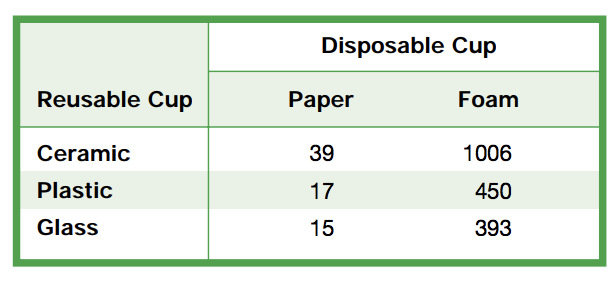Are Reusable Cups Actually Better for the Environment?
Nowadays, it is common to see people utilizing their own reusable bottle, mug, or cup. However, are they actually energy efficient? How much energy is required to create a reusable cup versus a paper cup?
A study conducted by professor Martin B. Hocking at the University of Victoria compared three types of reusable cups (ceramic, glass, and reusable plastic) to two types of disposable cups (paper and polystyrene foam). The study found that the energy required to create reusable cups is vastly larger than the energy of manufacturing disposable cups.
The table below displays the “break-even point” for how many uses are required for each reusable cup to be more energy efficient than either disposable cup. For example, a glass cup needs to be used an average of 15 times before it is considered more sustainable than a single-use paper cup.

There are valid reasonings for using either single-use or reusable cups. In order to reuse a cup, it has to be washed which requires water and soap. Hot water is not required for the majority of the time, but since mugs and cups are sometimes washed along with other dishes, they still use the energy required to heat the water. The dishwasher used to reuse a cup may or may not be very energy efficient.
On the other hand, reusable cups can be lost or broken which shortens its lifetime. They are also not very ideal for social gatherings and events where there are a lot of individuals. At the end of the day, it is up to the individual to choose what type of cups they use.
Written by Emily Su, Class of 2022.
Photo Credit: Friends of Earth

